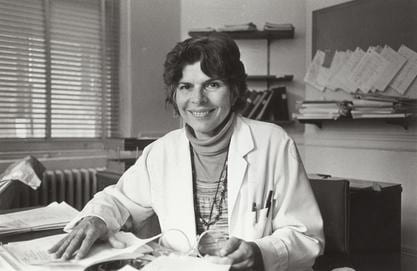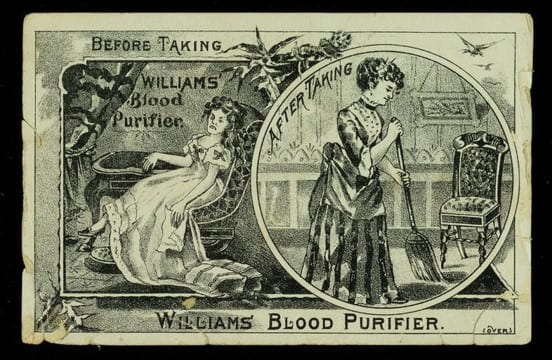It is nearly impossible to pinpoint the exact start of Irish medical history as many sources, both primary and secondary, have been lost to time. Thankfully with the aid of historical town annals and medical manuscripts stored in either a private collection or at an institution, historians can peer into ancient times and learn more about professional medical practices in Ireland. Like many cultures, the medical traditions in Ireland were uniquely tailored to the lives and societal norms of the time period, often adapting to changes in the social hierarchy. There are books, articles and other scholarly sources that provide analysis and detailed overviews on Irish medical practices and we hope this article will encourage you to learn more.
Medicine & Religion: Pre-Christian Irish medical history is believed to be closely tied to the Druids and druidic practices. Due to a lack of firsthand knowledge about the Druids, their beliefs and practices, historians must separate facts from myths often ending up with inconclusive results. In Irish mythology, the Druid “Diancecht' was known as the God of Healing and is said to have practiced hypnotism. He is said to have recognized fourteen disorders of the stomach.” (Woods, 1982 p. 35) Physicians and medical figures are woven into early Irish myths and legends, hinting at the importance of their profession during the ancient times when warfare was a common occurrence. “King Cormac who reigned in AD 227 made an order that all future monarchs of Ireland should at all times be accompanied by ten persons, a chief, a judge, a druid, a physician, a poet, a historian, a musician and three servants. This order apparently lasted until the death of Brian Boru in 1014 AD.” (Woods, 1982, p. 36) With the arrival of Christianity and the decline of the Druids, medical responsibilities shifted towards monasteries and Christian priests.
Newly built Christian churches and monasteries contained separate wards and small hospitals that were dedicated to the care of sick or injured individuals. In these sick wards, the priests and nuns attended to their patients, often relying on prayer or herbal concoctions as remedies. Plagues were a common occurrence. There are documented cases of widespread sickness in 250 AD, 664-665 AD and the end of the sixth century when the bubonic plague reached Ireland. During these times, the Christian church grew in power as many in Ireland found comfort in Christian teachings. “The miracles of Christ, the miraculous power entrusted to his followers and the belief in the resurrection after death, gave hope to the sick and those living amidst a plague, while the Christian ethos of caring gave practical comfort.” (Woods, 1982, p. 37) While secular physicians existed during these early times, for many years medical authority resided primarily with individuals and organizations tied to a religious background, starting with the ancient Druids before transitioning to the Christian priests once their faith reached Ireland. This union of medicine and religion lasted until the mid-twelfth century when medical authority once again shifted towards a new group of leaders and practitioners.
Hereditary Physician Families: The release of the ‘Papal Edict of 1163’ contributed to the downfall of the Christian church as a main source of medical authority. The edict prevented monks from performing surgery making it difficult for injured or sick people to rely on the church for care. As a result of this papal edict, hereditary physician lines grew in influence. Medical knowledge was usually passed from father to son even during the years when the Christian church was the primary healthcare provider. But from the mid-twelfth century to around the early seventeenth century, these hereditary lines established long-lasting connections with the Irish elites. These physicians were usually treated well and received fair compensation for their work. “The stipend usually consisted of a tract of land and a residence in the neighborhood, held free of all rent and tribute, together with certain allowances and perquisites: and the physician might practice for a fee outside his patron’s household” (Joyce, 1908, p. 267). Physicians were able to travel freely throughout the lands, even when they needed to travel into an unfriendly neighbor’s territory. These physicians typically possessed their own family medical book which contained medical treatises translated from other languages such as Greek or Latin as well as their own personal cures and recipes for common medicines.
Despite the tremendous influence and respect these physicians earned, the Brehon Laws, Ireland’s main legal system for centuries, offered basic protections for patients if their physician intentionally or unintentionally harmed them during a procedure. Under the Brehon Laws a patient or their family could pursue litigation against a physician for any wrongdoing and in most cases the physician was forced to pay a fine in retribution. While physicians were well-respected members of the communities, these early patient protection legal codes point to the underlying danger of ancient and medieval medical practices. Even without the presence of a national medical board to issue medical licenses, early Irish physicians were held to a high standard and medical malpractice could lead to financial and legal consequences.
Collection & Preservation of Medical Manuscripts: Early Irish medical professionals relied on books to expand their understanding of medicine and how to treat the injured or infirmed. There was an active attempt at translating medical texts from other countries into Irish. Some of these medical manuscripts are stored in the Royal Irish Academy and they provide insight into the budding international medical community that existed during early and medieval times. For example, ‘The Book of O’Lees’ “contains a translation from Latin into Irish of a highly organised medical treatise, with 44 tables outlining details of diseases, each divided into 99 compartments, across, aslant, and vertical. These are coloured red and black, and comprise descriptions of different diseases, showing name, prognosis, stage, symptoms, cures, etc., of the disease in question. There are rough decorative drawings at the top left margin of many pages.” (The Book of O’Lees [“Book of Hy-Brasil”]: Medical treatise, 2015, para. 1)
The Edward Worth Library is another prominent collection that contains many early Irish medical manuscripts and texts. Located in the Dr. Steeven’s Hospital in Dublin, this collection was donated to the hospital at Worth’s request after his death in 1733. “Edward Worth was a physician whose taste in books radiated outwards from his professional concern with medicine…Beside medical books, ancient and modern (ie. 18th century), one finds important contributions to the study of related sciences, then philosophy, the classics, history etc. Worth was particularly interested in the book as object: the collection not only holds fine examples of sixteenth-century typography but is also considered to be the best collection of early modern book bindings in Ireland.” (Edward Worth Library, n.d., para. 2)
The Edward Worth Library and the medical manuscripts in the Royal Irish Academy reveal an ancient medical community dedicated to learning not just from their fellow peers in Ireland, but from physicians and scientists abroad. The medical community did not work in isolation, but actively sought out other sources to improve their own craft and medical knowledge.
Understanding pre-Christian Irish medicine is difficult due to the lack of information about the Druids and their customs. We see that even during ancient times, the Irish had a growing community of physicians who were important figures in the community. These medical communities grew and flourished, often establishing hereditary physician lines that worked for the lords and kings with excellent compensation for their services. Thankfully there are ancient medical treatises and texts that show how Irish physicians actively pursued international sources that were translated into Irish. If you’re interested in learning more about Irish medical history then read some of the sources listed in the ‘References’ section below!
References:
Cunningham, Cantor, D., & Waddington, K. (2019). Early Modern Ireland and the World of Medicine: Practitioners, Collectors and Contexts. Manchester University Press. https://doi.org/10.2307/j.ctv18b5h6b
Joyce, P.W. (1908). A Smaller Social History of Ancient Ireland, Treating of the Government, Military System, and Law; Religion, Learning, and Art; Trades, Industries, and Commerce; Manners, Customs, and Domestic Life, of the Ancient Irish People. Longmans, Green, & Co., 1908.
Woods, J.O. (1982). The history of medicine in Ireland. Ulster Medical Journal, 51(1), 35–45.
The Book of O’Lees [“Book of Hy-Brasil”]: Medical treatise. (2015, August 31). Royal Irish Academy. https://www.ria.ie/library/catalogues/special-collections/medieval-and-early-modern-manuscripts/book-olees-book-hy
The Edward Worth Library. (n.d.). Edward Worth Library. Retrieved March 15, 2022, from https://edwardworthlibrary.ie/
Subtracting insult from injury: The medical judgements of the Brehon Law. (2013, March 7). History Ireland. https://www.historyireland.com/subtracting-insult-from-injury-he-medical-judgements-of-the-brehon-law/#:~:text=The%20Brehon%20Law%20was%20the























